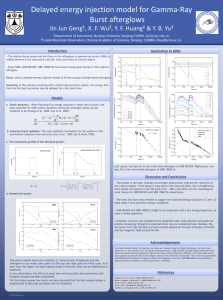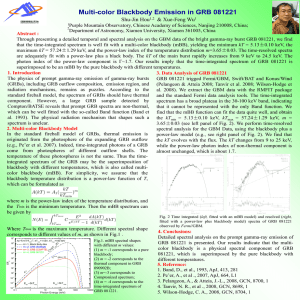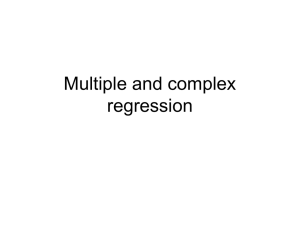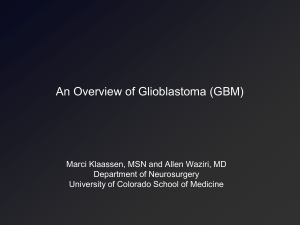9:50-10:30 J. McEnery (Invited): Observations of Gamma
advertisement
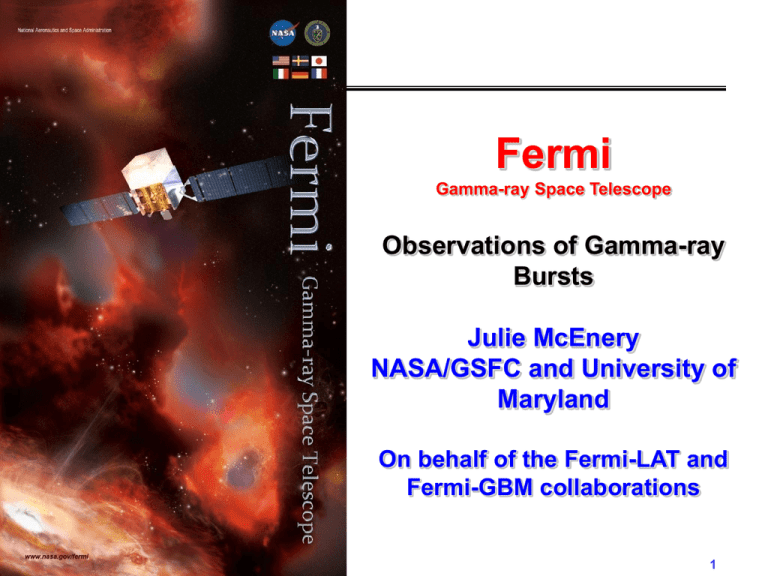
Fermi Gamma-ray Space Telescope Observations of Gamma-ray Bursts Julie McEnery NASA/GSFC and University of Maryland On behalf of the Fermi-LAT and Fermi-GBM collaborations 1 Fermi Observatory Large Area Telescope (LAT): • 20 MeV - >300 GeV • 2.4 sr FoV (scans entire sky every ~3hrs) Gamma-ray Burst Monitor (GBM) • 8 keV - 40 MeV • views entire unocculted sky Launched on June 11, 2008 2 All Sky Coverage LAT sensitivity on 4 different timescales: 100 s, 1 orbit (96 mins), 1 day and 1 year • • • In survey mode, the LAT observes the entire sky every two orbits (~3 hours), and covers 20% of the sky at any time. Can also perform pointed observations of particularly interesting regions of the sky. • Autonomously repoint for 2.5 hours following on-board detection of a bright, hard GBM burst GBM covers the entire unocculted sky 3 GRB090902B - Autonomous repoint • LAT – – – – – pointing in celestial coordinates from -120 s to 2000 s Red cross = GRB 090902B Dark region = occulted by Earth ( z>113°) Blue line = LAT FoV (±66°) White lines = 20° (Earth avoidance angle) / 50° above horizon White points = LAT events (no cut on zenith angle) 4 Fermi and GRB • • • LAT: <20 MeV to >300 GeV. With both onboard and ground burst triggers. GBM: 12 NaI detectors— 8 keV to 1 MeV. Used for onboard trigger, onboard and ground localization, spectroscopy: 2 BGO detectors— 150 keV to 40 MeV. Used for spectroscopy. Total of >7 energy decades! Good spectral observations of the prompt phase of lots of GRB 5 Alerts and Data Flow 1s Instrument Trigger(s) Fast signal GBM>LAT 10 s Alerts and updates 100s 1000 s 103 s Repoint Repoint to GCN with request request localization GBM- LAT->SC >LAT Science processing parameters reviewed by Users Committee • 104 s Slew to keep burst within LAT FOV (dwell time 2.5 hrs) 105 s Regularly-scheduled data downlinks (10-12/day) Planned repoint frequency (adjustable): • bursts starting within LAT FOV ~2/month • bursts starting outside LAT FOV ~2/year Onboard processing (both LAT and GBM) - GCN alerts: location, intensity (cnts), hardness ratio, trigger classification (GRB, solar flare etc) • GBM Prompt ground processing (10-30 mins): updated location, lightcurve. Quicklook GBM products available at FSSC • • GBM Burst Advocate localization LAT ground processing (5-15 hours): updated location, high energy spectrum, flux (or upper limit), afterglow search results. LAT count data available. • Final ground processing (24-48 hours): GBM model fit (spectral parameters, flux, fluence), joint LAT-GBM model fit, raw GBM data available. 6 Science Data Availability No proprietary gamma-ray data - Everyone gets access to the data at the same time Latency requirement is 72 hours, typical latency is much less ~<10 hours • LAT and GBM instrument teams generate additional high level data (lightcurves, transient alerts, pulsar timing solutions etc) which are served to the community by the FSSC 7 GBM Triggers/Month • Nov 9, 2009 - add new TGF trigger • TGF trigger rate increased by factor of ~10 to 1 per 3.7 days 8 Fermi GRB detections GRB 130427A GRB 131108A 14 LAT bursts with measured redshift from z=0.145 (GRB130702A via iPTF!) to 4.35 (GRB080916C) 9 GBM Spectra - Thermal Components? GRB100724B - bright GBM burst Non thermal Expect thermal/blackbody component from photosphere • Black body components have been fit in several GRB - GRB080916C, GRB090902, GRB100724B… Guiriec et al, 2011, Ryde et al 2011 Total Non thermal Thermal(kT≈ 38keV) kT~constant, evolving nonthermal component 10 Continuous high time resolution data • The initial GBM configuration was to return count rates binned in time and energy. – After an onboard trigger enhance time and energy resolution of the binned data for 10 mins and collect individual time-tagged events for ~5.5 minutes. • On November 26, 2012, we transitioned to continuously collecting time-tagged event data – This allows for sensitive ground-based analyses on short timescales • Excellent for TGFs, which typically have durations less than the shortest onboard trigger integration time. • Also helpful for searches for sub-threshold short GRB, precursors etc. • Pipeline to search for SGRB offline is currently under development by the GBM team. 11 GBM Localization Contours • GBM’s strength is its broadband spectral coverage of the prompt emission of GRB, its weakness is relatively poor localization – 68% containment: 15o (1st FSW), 11.5o (last FSW), 7.5o (GA), 5o (HitL) • The GBM team have developed new data products to support follow-up observations of GRB locations. – Location of the GRB along with 1, 2 and 3 sigma contours that include both the statistical and the current best-guess systematic uncertainties on the GBM localizations. • Already two successful follow-ups with iPTF using the contour files (130702A & 131011A) • These localization products will routinely be made publicly available from the FSSC. • Please see Adam Goldstein’s poster (or talk with Adam) for more details. 12 Fermi-LAT Observations of GRB • Onset of >100 MeV delayed w.r.t. keV flux • Durations of high energy emission longer than keV emission – Spectral and flux variability greatest at early times – Spectral index ~constant at later times • Hard power-law components seen in bright LAT GRB • Cutoffs -> fewer detected GRB than hoped • MeV-GeV counterparts to X-ray flares? 13 Energetics of Fermi-LAT GRBs 130427A • LAT GRBs are among the most energetic both intrinsically and observationally 14 Comparing MeV to GeV emission • The GeV fluence is typically ~10% of the MeV fluence. • The two short GRB may be exceptions to this, but need more short GRB to confirm. 100% 10% 1% 15 Highest Energy Photons Highest energy photons provide constraints on the acceleration/emission processes (need to be able to produce the photons) and on conditions in the emission region (need to be able to get them out) • The highest energy photons are not correlated with spikes in the prompt emission lightcurve, and often arrive after the end of the prompt emission 16 Delayed onset of >100 MeV Emission • The LAT >100 MeV emission starts after the keV emission, sometimes by up to 80 seconds • Seen for both long and short GRB 17 Duration Distributions • We measure a systematically longer duration in the LAT – Emission at GeV energy lasts longer than the emission at MeV energy 18 Extra power-law components in most bright bursts Ackermann et al ApJ Abdo, A. A., et al. 2009, ApJ, 706, L138 GRB 090902B Best fit spectrum to interval b (T0+4.6 s to T0 + 9.6 s) is a band function (smoothly broken powerlaw) + power-law component. GRB090510. First bright short GRB Clear detection of an extra component, inconsistent with the Band function. 19 GRB090926B • Sharp spike seen at all measured gamma-ray energies – Strongest below 15 keV and above 10 MeV – Clear correlation between keV and MeV/GeV lightcurves Ackermann et al, 2011 20 GRB090926 - extra spectral component • • Hard power-law component emerges during the bright spike, with cutoff at 1.4 GeV Power-law index remains constant through the afterglow (~5000 seconds) 21 Long-lived Emission with powerlaw temporal decays GRB 090510 GRB 090902B De Pasquale, M., et al. 2010, ApJ, 709, L146 GRB 080916C 22 Breaks in the extended emission • Significant (>3 sigma) breaks seen in 3 bright GRB • Transition from prompt to afterglow? 23 LAT Detection during X-ray Flare Activity • GRB100728A – Bright GBM burst->ARR – No prompt LAT detection (but was at edge of FoV, 58 deg) – Hard spectrum (1.4+-0.2) – Gamma-ray fluence consistent with extrapolation of the X-ray flare spectrum – Unable to distinguish between afterglow or flare emission due to weak LAT detection • Sample of 140 Swift GRB – 49 (35%) show flares at early times – 12 with good LAT observations (in FoV and away from Earth limb) – 29 flares with simultaneous Fermi/Swift observations, 1 detection! 24 How fast is the emission region moving? • • • Relativistic motion of the emitting shell: – A relativistic motion of the shell allows higher energy events in dense region to escape. – Observing high-energy events correlated with the fast variability allows us to constrain to the speed (Gmin) of the emitting shell. For target photon spectrum assume band function, or powerlaw. Caveat : target photon field assumed uniform, isotropic, timeindependent – More realistic modeling yields significantly (~3 times) lower values 25 GRB130427A • One of the brightest GRBs in gammarays ever detected – Energy released in gamma-rays ~1054 erg • Highest energy photon (95 GeV) • Longest lasting GeV emission – LAT detected emission for over 20 hours • Redshift = 0.34 26 GRB130427A Synchrotron emission? Equate radiation and acceleration timescales • The high energy LAT-detected photons challenge synchrotron origin from shock accelerated electrons 27 GRB131108A • First onboard LAT detection in 4 years! • Very bright burst in LAT • Triggered Swift TOO based on LAT onboard location – Swift found the X-ray afterglow • Analysis is ongoing, but initial analysis suggests: – Softer than usual LAT spectrum – Highest energy LAT photon just 1.5 GeV • The bright Fermi-LAT burst drought is over! 28 The Future • We are continuing to find unusual bursts – GRB130427A, GRB131108A • Planned improvements to LAT FSW to boost LAT onboard trigger rate (by taking advantage of the GBM->LAT fast signal) • New observatories coming online especially high energy and multi messenger – HAWC (wide-field TeV observatory) – VERITAS, HESS2, MAGIC etc – Unique opportunities for joint gravitational wave/photon detections of binary mergers with advanced LIGO and Fermi • New GBM localization data products, possible localization improvements • Significant improvements to LAT data reconstruction will bring increased effective area, field of view and angular resolution 29 Updated event reconstruction Analysis and configuration improvements coupled with robust hardware means that we will continue to expand LAT science capabilities • The LAT collects a significant amount of information for each gamma-ray event – Ground processing reduces this to directions, energy, event type (gamma-ray or background) and associated errors – Extensive scope for analysis improvements tailored to specific science questions or scenarios – Extensive rework of low-level algorithms is currently in progress, ready for release in 2014/2015 Factor of two increase in acceptance at 100 MeV 30 GRBs and Gravitational Waves Fermi-GBM and Advanced LIGO (>2015) should see coincident Gravitational wave/Electromagnetic emission or rule out NS-BH mergers as the progenitors of short GRB Large rate of short bursts in GBM is key to coincident detections GBM Short GRBs in ALIGO horizon: N(z<0.11, NS-NS) ~ 2+4 yr-1 -1 -1 N(z<0.22, NS-BH) ~ 8+6 -3 yr • Both observations bring complementary information: ALIGO → inspiral characteristics ; Fermi → jet properties & environment 31 31 Summary • • • • • 250 GRB/year detected by GBM ~10 GRB/year detected at high energy by the Fermi LAT Prompt emission observed over a wide energy range • Delayed time onset between the LAT and GBM data • Extra spectral components in most bright bursts • High energy cutoffs in several GRB • Thermal components in several GBM detected GRB • Band model is no longer the best phenomenological model Temporally extended high energy emission is common • Likely related to early afterglow, very constraining to emission/acceleration models • Flux decreases as a power-law with time • 3 bursts observed to have breaks in the temporal decay Bright GRB challenge standard models • GRB130427a challenges commonly accepted models • Look out for new results from GRB131108A 32

